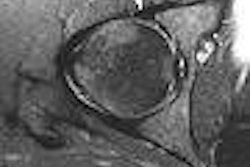MRI is the imaging gold standard for many soft-tissue cancers. The fine resolution of high-field MR has proved its effectiveness in differentiating, defining, and locating tumors within the body, but despite its diagnostic efficacy, treatment options aren't to be found in the MR department, rather in radiation therapy and oncology.
Even for treatment planning, MRI has taken a back seat to CT -- even with soft-tissue tumors -- and PET provides superior metabolic data on what is happening inside the tumor. But what if MRI could be used more effectively as a treatment planning tool? What if a single trip into the bore could not only effectively diagnose cancer, but also treat it?
First, treatment planning: LAP, a Lüneburg, Germany-based manufacturer of laser positioning systems used in CT suites for radiation therapy treatment planning and simulation, has developed a laser positioning system for MRI suites. This allows the modality best suited for identifying many tumors to be used to position the patient and locate the mass for optimal radiation therapy treatments. Specific spatial location of tumors for radiation therapy is crucial, so some MR systems may not have the spatial accuracy to be used in this capacity.
For treatment monitoring, Midwest RF of Hartland, WI, has developed a specialized radiation oncology head coil that has been designed to accommodate the thermoplastic head immobilizer used in radiation therapy. This enables serial imaging in a constant position, allowing for better comparison of actual images to the treatment model, as well as a consistency of view, enabling tomographic views at precisely the same location at different stages in treatment.
Actual real-time MR-guided cancer treatment has been a reality in Europe for years and may be on the horizon in the U.S. as well. BSD Medical of Salt Lake City has developed a deep-tissue phased-array radiofrequency (RF) hyperthermia device that can be used to potentiate both radiation therapy and chemotherapy. When used in conjunction with the integrated body coil of the 1.5-tesla Symphony MRI (Siemens Medical Solutions, Malvern, PA), the RF heating can be directed, both in location and intensity, by MR imaging.
Localized hyperthermia, heating cancerous or necrotic tissues to between 40° and 45° centigrade (100° to 110° F), increases perfusion and dramatically enhances the efficacy of both radiation therapy and chemotherapy. When hyperthermia is used in conjunction with either or both of these therapies, remission and survival rates for cervical cancers have been shown to be substantially improved. Other cancers are currently being studied and the hyperthermia device is currently in the U.S. Food and Drug Administration review process.
The BSD deep-tissue phased-array RF hyperthermia device can be operated without direct MR feedback of temperatures within the body, relying instead on catheter heat sensors that are inserted to the tumor site under either MR or CT guidance. The pending FDA approval is for the operation of the device without MR guidance, but if proved effective and reliable, why wouldn't the FDA allow the technology to progress to the next step and become truly noninvasive?
MRI suites have been at the crux of a shift from strictly diagnosis to a small, but steadily growing, number of interventional and treatment applications. We've seen the beginnings in other clinical disciplines besides oncology, but it's time we recognized that the application of MR technology is finding its way into new areas, many of which show tremendous promise for growth in the years ahead. This will call upon hospitals and radiologists to find new ways to collaborate and share the technologies as they're deployed.
Interventional applications also challenge the operators of today's MRI systems. Many suites were developed without any thought to interventional procedures, and these new applications may require different physical facilities, staff, equipment, and technologies.
But despite these hurdles, technological advances, clinical needs, and financial pressures will continue to push new applications to MRI. We may not automatically associate MRI with oncology today, but in a few years the modality may have a significant toehold in the diagnosis, treatment, and monitoring of many cancers.
Facilities looking to prepare their MRI suites for oncology treatment should consider the following:
Laser simulators, hand sinks, procedure lights, and storage for new coils and devices all require space within the suite. Design MRI rooms with additional square footage to enable these additional capacities.
Converting an operational diagnostic-only MRI to support interventional procedures can be a major undertaking. Anticipate this potential future conversion and provide wave guides, rough-ins for plumbing and piping, and provisions for power and support to new devices within the magnet room.
Infection control protocols for interventional applications may be significantly different from those for other diagnostic uses. Consult your infection control agent and review the finishes and systems you have in your magnet room with in-house staff and expert designers.
Considering the costs of MRI technology and the specific building requirements needed to support it, it is very wise for facilities contemplating new equipment or expanded facilities to carefully evaluate the nascent areas of enhanced MRI diagnostics and treatment. These new functions, which may be tomorrow's clinical standard or revenue gold mine, will require more of MRI suites than "typical" layouts currently provide. Effective planning is needed for these eventualities. Whatever ambiguities may be in the future of MRI, it is clear that there is little question about its growth in oncology diagnosis and treatment.
By Robert Junk and Tobias Gilk
AuntMinnie.com contributing writers
February 1, 2006
Reprinted from www.mri-planning.com by permission of the authors. If you would like more information on any aspect of MR facility design or safety, please contact Robert Junk or Tobias Gilk at Jünk Architects.
Related Reading
MRI and cancer diagnosis, January 6, 2006
Hurricane epilogue: An MR emergency preparedness primer, December 26, 2005
MRI vendor suite templates: What they don't show, December 8, 2005
Hitting the ceiling over HIPAA-required walls, December 6, 2005
Burying MRI construction mistakes: What you cannot see affects what you can, November 23, 2005
Copyright © 2006 Jünk Architects, PC



.fFmgij6Hin.png?auto=compress%2Cformat&fit=crop&h=100&q=70&w=100)




.fFmgij6Hin.png?auto=compress%2Cformat&fit=crop&h=167&q=70&w=250)











